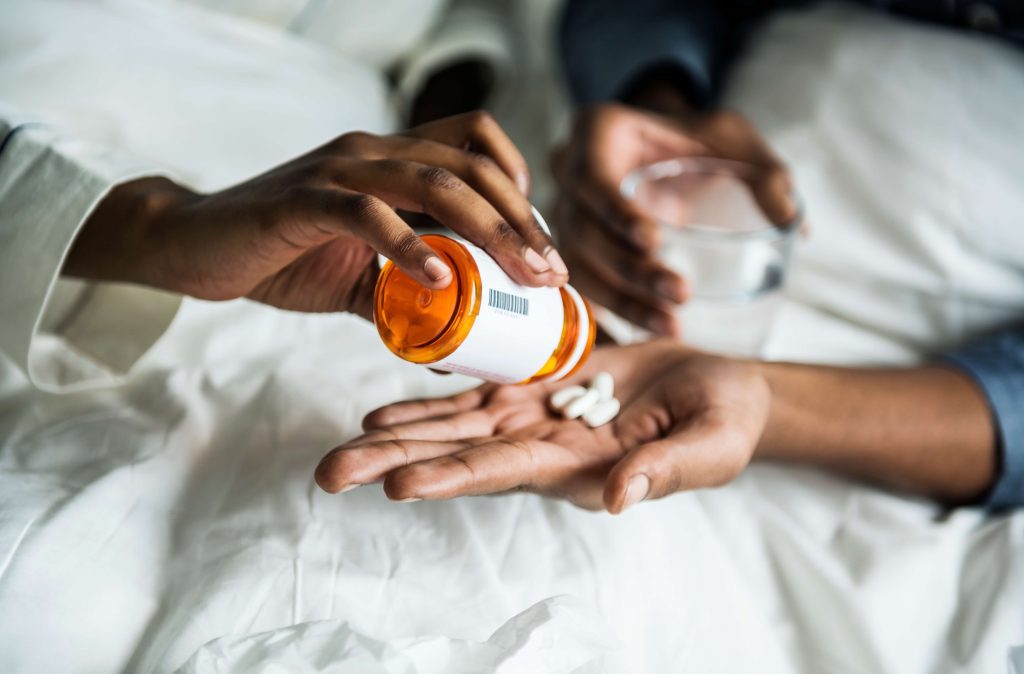Why Are Opioids Addictive?
Opiate abuse has become a crisis in our nation and has even been declared a public health emergency. Accounts of opiate addiction are increasing at an alarming rate and are often associated with prescription drug abuse and misuse. With opiate addiction being so high, both the public and the medical community are calling for alternatives to this once-respected treatment. Below is a sampling of the type of effects this drug has on the brain and body. According to the Centers for Disease Control and prevention, in 2019, opioids dispensing rates continued to remain very high in the USA:
- In 5% of U.S. counties, enough opioid prescriptions were dispensed for every person to have one.
- 153 million Opioid Painkiller prescriptions were written in 2019
- The overall opioid dispensing rate in 2019 was 46.7 prescriptions per 100 people, and some counties had rates that were six times higher than that/

Do You Know The Difference Between Opiates and Opioids?
Both opiates and opioids are used medically. They may be prescribed for pain relief, anesthesia, cough suppression, diarrhea suppression, and treatment of opiate/opioid use disorder. Both opiates and opioids may also be used illicitly by people with substance use disorder. The main difference is in how opiates and opioids are made.
The poppy plant creates opiates. Opiates are labeled as “natural” because nature creates the active ingredient molecules. Common opiates include opium, morphine, and codeine, both made directly from poppy plants.
An opioid is a substance (molecule) that is synthetic or partly synthetic. This means the active ingredients are created chemically. Opioids act like opiates in the human body because of their similar molecules.
Opiates are narcotics derived from the opium poppy (natural).
Opioids are narcotics that include natural opiates and semi-synthetic opioids, and synthetic opioids created in a laboratory.
Sometimes people refer to opioids as synthetically generated narcotics and opiates – narcotics delivered from natural plants.
Effects of Opioids on the Brain
Opioids cause changes in the brain through binding to certain receptors. These receptors are instructed, by the drug, to release chemicals. These chemical releases are similar to those which otherwise occur naturally through engaging in pleasurable activities. Not only does the brain come to rely on this artificial release, but it can also begin to associate certain situations with the anticipation of receiving the drug. This association is best known as Pavlovian conditioning, where places, events, and scenarios can trigger a user’s desire for the drug.
Over time, the brain can develop a dependence on the effects of the drug. What was once able to be produced naturally has now received the message that it is no longer needed. In a sense, the brain gets lazy. An individual is subtly encouraged, by the brain, to continue supplying the needed chemicals through consumption of the substance.
With dependence comes tolerance, or the need to consume higher levels of the drug to produce similar pleasure. The receptors for the opiates become desensitized, and more of the drug is needed to experience prior sensations of gratification. Those using opioids for pain relief are likely to experience breakthrough pain and will commonly seek a higher dosage from their practitioner to manage it. Those using opioids illegally will find that they are not experiencing as much of a high and may engage in drug-seeking behavior.

The effects of opiate usage on a developing brain are very pronounced. Studies of children exposed to opiates in utero reveal that exposed children suffer from lower mental capabilities, regardless of how they are raised after birth. This impairment of cognitive ability does not improve and has been found to get even worse, over time, for some. Children exposed to opiates before birth can suffer for life.
The physical structure of the adult brain is also affected by opioid dependence. Those with a prolonged history of usage were discovered as having the less gray matter in the frontal areas of the brain than the average non-user. Not only does gray matter hold the neurons for physical activity, but it has also been found to regulate social attitudes, such as the extension of empathy and exercise of conscience. This lends itself to the concept that prolonged opioid usage reduces the user’s ability to engage in compassion and pro-social behavior. As these studies of reduced gray matter were conducted on deceased individuals, it is not known whether the matter can be recovered after abstaining from the drug.
Before the growing awareness of the dangers of prescribing opioids, the drug was even considered as a solution for binge eating and obesity. The properties of the drug were found to block the receptors in the brain, which affect the release of pleasure chemicals related to eating, thereby causing enjoyable foods to lose their appeal. An opioid user can lose the ability to enjoy eating.
Effects of Opioids on the Body
Opiates reduce heartbeat and breathing rates, which contribute to the sensation of being relaxed. However, the downside of this depression of aerobic activity is that the brain is often not able to receive enough blood and oxygen to function properly. In cases of overdose, the ability to breathe becomes impossible, and many have died due to a lack of oxygen to the brain.
Regarding the effect of opiates on appetite, the impact on the body can go either way. In one instance, a user may find that the lack of pleasure gained from eating – especially when combined with experiences of nausea and vomiting – results in severe weight loss. In other instances, the user will find her or himself consuming even more food to regain the pleasure of eating. This latter scenario can contribute to obesity for the user. Both undernourishment, and over-nourishment, are significant physical health risks.
There are also gastrointestinal effects. Opioid users can suffer from an acute form of constipation called OIC. This occurs due to the substance relaxing the intestinal function, resulting in a build-up of matter. When the intestines are not clear, they cannot absorb fluid and nutrients, which can lead to dehydration and further malnutrition. The prescribing of oral laxatives is often called for in these situations, which can be problematic if the user is also suffering the common side effects of nausea and stomach pain.
As if these effects were not enough, prolonged opioid use can also negatively affect sex drive, sexual drive, and performance. Erectile dysfunction has been noted in males who use opioids, and desire decreased for both males and females using the drug. In addition, males who persist in opioid usage can suffer a sharp reduction in testosterone production.
The experience of physical withdrawal from opiates can be extremely unpleasant for the body. The withdrawal process can begin within 1-2 days from the last dosage and can begin with a feeling of being on edge. The symptoms can mimic the severe flu, complete with nausea, diarrhea, and chills as it progresses. Treatment centers can be utilized to reduce the severity of these symptoms while detoxing from the drug.
Why Are Opioids Addictive?
The negative effects of opioids don’t end with these detriments to the brain and body. There are many more consequences, some of which are only now being studied. In addition, those struggling with opioid abuse and addiction often experience psychological and relationship trauma, as well, which extends the issue far beyond physical concerns. If you or a loved one are struggling with addiction to opiates or another substance, reach out to Lifescape Recovery today. Our drug abuse treatment program can help you get back on your feet.


Lifescape Recovery Mental Health is a top-rated mental health and addiction treatment facility in Los Angeles, California. We create a safe space for patients to explore their mental health goals and needs. We offer a free, confidential consultation to any new clients and provide a number of different therapies to treat a wide spectrum of mental health struggles such as depression, anxiety, eating disorders, and substance use disorders. Our IOP and PHP facility is fully accredited. We are one of the highest-rated centers for mental health treatment in Los Angeles, California, which provides both in-person and online therapy. Our patients express endless gratitude and appreciation for the staff and the services and recommend Lifescape Recovery for their friends, colleagues, and community. There has never been a more important time to address mental health needs! Contact us today!
Published: June 14, 2022
Last Updated: July 22, 2024

Published: September 26, 2025
Understanding Personality Disorder Clusters: Personality Disorder Cluster A, B, and C
Personality disorders are long-standing patterns of behavior, thoughts, and emotions that can create difficulties in relationships, work, and daily functioning. Instead of being flexible and adapting to life’s situations, these patterns remain rigid and cause distress. The DSM-5 (Diagnostic and Statistical Manual of Mental Disorders, Fifth Edition) organizes personality disorders into three groups, called clusters. […]
Read more
Published: September 05, 2025
Understanding Borderline Personality Disorder (BPD): Causes, Symptoms and Treatment
Borderline Personality Disorder (BPD) is a complex and often misunderstood mental health condition marked by intense emotional instability, turbulent relationships, and an overwhelming fear of abandonment. As a Cluster B personality disorder, BPD can make everyday life feel chaotic and overwhelming—but with tailored therapy, individuals can learn to regulate emotions, build meaningful connections, and thrive. […]
Read more
Published: August 24, 2025
Understanding Histrionic Personality Disorder (HPD): Causes, Symptoms and Treatment of HPD
Histrionic Personality Disorder (HPD) is more than being dramatic—it’s a serious mental health condition that can disrupt relationships, careers, and self-esteem. Belonging to Cluster B personality disorders, HPD is marked by attention-seeking behavior, shallow but intense emotions, and a constant need for approval. Left untreated, it often creates cycles of frustration and conflict, but with […]
Read more
